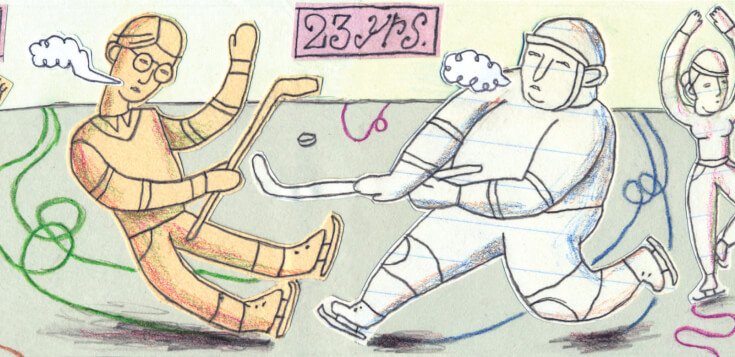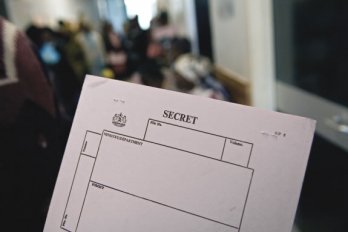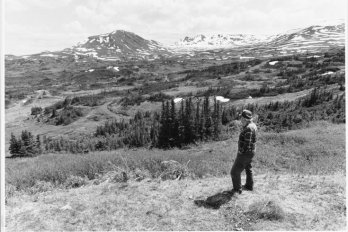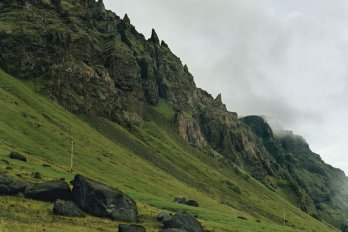The Earliest Memory—Somebody is holding me up. Somebody has his hands under my arms and is holding me up. My father, I’m pretty sure. I am wearing brown woollen britches and skates, runners they are called. Or maybe bobskates. Each skate has two blades. I’m on a frozen piece of sidewalk, a frozen puddle outside my grandmother’s house in Toronto’s east end. Am I four?
A Later Memory—An outdoor rink at night. Music playing on the loudspeakers. The Crew Cuts and Sh-Boom. Couples holding hands or with arms entwined are skating around and around. I am holding onto my cousin Marilyn, who is blond, three or four years older, and beautiful. My ccm skates are bent over, and my ankle bones almost touch the ice. As soon as I right one foot, the other goes skittering off in the opposite direction. I try to push forward. I feel my verticality going, slipping away, so I try to shift my weight upward and back. This pitches my head and shoulders back even further. Now I’m falling backward instead of forward. Marilyn tries to catch me. My skates shoot out in front, my legs splayed. I land on my coccyx, the vestigial tailbone. I whimper, then cry. People look at me as they glide by. Am I nine?
A Final Memory—I am working as a City Hall reporter for the Globe and Mail. Somebody suggests creating a newspaper hockey league for reporters and editors on the three dailies. We rent an arena in north Toronto where we can play cheaply from midnight to one in the morning. I sign up.
I don’t broadcast the fact that I can’t play hockey, indeed can’t really skate. I ask the guy if I can play goal. No, they already have a goaltender with all the pads and appropriate gear.
I am assigned left wing. It is a desperate thing that I am doing. The potential for ridicule is operatic. I use the hockey stick to steady myself, to find and hold my balance. I pray the puck doesn’t come my way. When it does, I quickly shoot it ahead wildly in the direction of the net, then fall to the ice.
All night I avoid any physical contact, until one very fat man on the other team ripples me into the corner boards. I hit the ice. There is blood. I feel great. I have become a bloodied hero. I am no longer the skinny boob with glasses who can’t skate. I feel like my hero Ted Lindsay of the Detroit Red Wings. I get up slowly and weakly push off in the direction of the bench; “No. No, I’m all right, really.”
Am I twenty-three? Will I ever learn to skate?
The hell with it, I say to myself.
Forty years later, in the season of the Great Empty, I am clinging to the boards of an outdoor ice rink in Toronto’s west end waiting to take my first skating class for adults. It is a coincidence that I’m here in the season of the nhl lockout. I never watch hockey, couldn’t care less if the teams are locked out forever. I do not ever want to attempt to play hockey again. It is my intention to skate the Rideau Canal in Ottawa, lengthwise, in deep February. All 7.8 kilometres.
The class reflects Toronto’s celebrated multiculturalism. There is an Iraqi Kurd, an Englishman from Newcastle, a young woman from south India, a Bosnian, a young man born in Jamaica. They all have two things in common: none of them can skate, and they each have a good excuse. Unlike me. I am Canadian-born, the product of winter country. In the midst of the foreign-born, I am the outsider on ice.
In my mind I work through the welter of excuses, the oft-rehearsed reasons for my failure to skate. Medical—I had severely weak, almost deformed, ankles as a child; familial—I was a late child and both my parents were too old to teach me; financial—we lived in a poor part of town and I couldn’t afford streetcar tickets to the rink; cultural—I preferred baseball to hockey; physical—too cold and too many ice bullies.
It takes something approaching an act of will to avoid learning to skate in this country. It is almost a prerequisite to citizenship. My ignominy is compounded by the fact that I went to a hockey high school, the most famous hockey high school in the world—St. Michael’s College School, whose motto is Doce Me Bonitatem et Disciplinam et Scientiam. Teach Me Goodness, Discipline and Knowledge.
On my very first morning at St. Mike’s, I bumped headlong into Frank Mahovlich, the greatest star on the great team. He was then an upperclassman, in Grade 13. I was a lowly Grade 9, trying to find my locker. We were both wearing our blue school blazers, his a bit worn, mine brand new, with the school crest on the breast pocket. I apologized in a nervous voice. He said it was all right, that it was his fault. His voice was high-pitched, just shy of squeaky. The most famous junior hockey player in the country, apologizing to me.
St. Mike’s was then a working-class Catholic high school, most of the boys Irish or Italian. If your family had money, you went to De La Salle. We hated Del. The place reeked of money and privilege, a kind of Catholic Upper Canada College. And their teachers weren’t even real priests, merely brothers. In 1961, when St. Mike’s won the Memorial Cup, some friends and I roared our junk heap of a car up Avenue Road to Del to tear around the campus, screeching our contempt.
The St. Michael’s Majors was the most famous junior hockey team in the country, and its graduates populated the nhl with some of its greatest stars—Red Kelly, Ted Lindsay, Dick Duff. Joe Primeau. Dave Keon was in my French class. Gerry Cheevers was in my year. Cesare Maniago and Arnie Brown were a couple of years ahead of me, Mike Walton a couple behind. The Majors were coached by the legendary Father David Bauer, who later established Canada’s international hockey presence.
Lefty Bauer was an amazing man and an inspirational coach. His brother Bob was a member of the Boston Bruins’ fabled Kraut Line, alongside Woody Dumart and Milt Schmidt. Everyone but Bauer himself said he could have played in the National Hockey League. Instead, he became a Basilian priest and teacher. He was my homeroom teacher for two years and I never let on to him that I couldn’t skate. Throughout high school, I played basketball, a bit of football, and some field sports. I kept my secret about being a non-skater and stayed away from the rink.
Something about the shame of those skateless years must have planted a seed of regret that chose to germinate all these years later. Which is why, at age sixty-two, on a cold November night, I am standing in the hockey section of that cathedral of Canadian consumerism, Canadian Tire.
The sales clerk tells me he is from Lahore, Pakistan, but he knows everything about skates, and will sharpen them, free of charge.
I ask for a pair of ccms, size eleven. He frowns.
“How are your ankles?”
“Non-existent.”
He says the ccms are better for a skater of some experience or a hockey player. For the novice, he recommends a pair of skates by Nike. All I know about Nike is sweatshops and running shoes; I’m surprised to learn they make skates. The Nike skates apparently are renowned for their ankle support system. That’s what he calls it, a system. I buy them.
While my friend from Lahore is sharpening the skates, I prowl the aisle looking for a helmet, size large. In my day, no one in the nhl wore a helmet, which made the players instantly recognizable, rendered them human. You didn’t have to read their names on the backs of their jerseys. I try on perhaps five helmets, all marked large. They are all too small. No helmet, I’m out of the class. I scan the web. I drive to hockey stores and Wal-Mart and used sporting goods stores on the fringes of the city. Finally at a distant Tire, I find a helmet that fits—barely—but hurts my ears. I buy it.
Lesson one: Our teacher is a woman in her early twenties named Debbie Cabral, whose family is Portuguese. Her skating is poetry in motion. Every move is supremely economical; not too much or too little. She makes it clear to us that she is no handholder. She will show us what to do but, once shown, it will be up to us. Debbie gives us our first exercise. We are to take little baby steps up and down, walking gingerly across the ice. We are not to think about gliding, just baby steps, lift one skate, put it down, lift the other skate and so on. On the third step I crash to the ice, hitting my right elbow. The next day I am back at the Tire buying elbow pads.
Lesson two: Realizing the parlous state of our expertise, Debbie decides to teach us how to fall. In my case, learning to fall is a bit redundant, simply grafting a technique onto what I’ve been doing since I started. More importantly for me, she teaches us how to get up after a fall. We raise one leg, bent at the knee, then use it to push up the other leg.
Debbie thinks my skate laces are too tight, causing my feet to go to sleep. I loosen the laces. I fall down again. I think about my hockey hero, Ted Lindsay. Small and deft, wired to some internal isotope that fired him around the rink like a pinball. Fists like tiny razors. Lindsay captured my imagination in a way no other sports figure, with the exception of Ted Williams, has. They had something in common, a contempt for losing and the determination to be their own man. As I get up, I think of little Ted and the face of a thousand stitches and wonder if I should buy a Red Wings jersey.
Lesson three: In this class, Debbie teaches us how to push off on the lead skate and shift weight to the other, to push from back to front, essentially, to create a forward rhythm. She follows this with a basic lesson on balance. She shows us how to glide on one skate while lifting the other and holding it to a count of ten.
The instant I raise my left skate, the right slips out ahead of me. I come down hard with the left skate to compensate and stay upright. I shift my weight to the rear. This causes me to lose my purchase on the ice with the right skate.
I crash to the ice, full weight coming down on my left knee. The pain shoots directly from the patella to my brainpan. I cry out and begin to writhe around on the ice. The pain is stupefying. Debbie and my classmates are solicitous. The next day I am back at the Tire, looking for knee pads. The pads are too clunky, so my friend Reynold Gonsalves, who was born in Jamaica, lends me his Rollerblade knee pads. Now in terms of body armour, I have the helmet, the elbow pads, the knee pads. I look like my son’s Ninja Turtle.
The six of us in the class are quite purposeful. Like me, Nick, the quiet Englishman, wants to skate the Rideau Canal from Dows Lake to the Chateau Laurier. Reynold wants to enjoy winter more. Ali Mustapha, the Iraqi, is an engineer and does something with computers. His attention is somewhat distracted by the upcoming Iraq elections in January. He will vote in Mississauga, the first time in his life he has cast a ballot in a free election. He is quite excited, smiling at the prospect. He is desperate to learn how to skate.
Lesson four: We have moved from the baby steps and the leg lifts to a wobbly kind of gliding. Gingerly we push off on the back skate and move down the rink. This confronts us with a whole new concept: stopping. I have been stopping simply by running into the boards and collapsing in a heap on the players bench or just by falling to the ice.
Debbie shows us how to stop by dragging one skate behind and athwart the other skate. She tells us we will graduate to the hockey stop, where you lift and turn on both skates and send up a rooster tail of ice spray. I watch how she does it and, cringing with skate envy, realize I will never be able to do it like her.
The moment of liftoff, that Wright brothers moment, comes when I successfully negotiate an end-to-end passage of the rink without falling down. It is actually quite magical.
Like stopping, turning is crucial. There is not much to be gained if you have good forward progress, can come to some kind of stop and yet cannot turn. The preferred method is to lift the outside leg, the one opposite to the direction of the turn, and gently cross it over the other leg, weight shifting all the while.
Impossible. Every time I lift the turning leg, I fall before I can make the crossover. While I am trying to learn how to turn, Debbie has moved on and is teaching the rest of the class how to skate backward. Clearly I’m falling behind. I feel like the huge kid at the back of the Grade 8 classroom who has been there for three years.
I used to love watching Doug Harvey play defence for the Montreal Canadiens. It seemed he could skate backward forever and never miss a step, always keeping his focus on the opponent with the puck in front of him. I fantasize about the hockey heroes of my youth.
As New Year’s Eve passed, I knew I would have to accelerate my learning curve if I was going to skate the Rideau. I continued practising and followed the weather forecasts. One day in March, I read in the Ottawa Citizen that the canal was closing to skaters. I would have to wait, like a Cubs fan, until next year.
In the summer I became determined, obsessed almost, to build myself up for the coming winter. I loathe winter and all its works, and in the high heat of summer give it no thought. But because I had missed my chance at the canal in March, I was determined to be ready for winter.
I began going to the health club with a regularity I had not engaged in before. I worked out a routine. I tried to visualize the canal in February, the bitter air, the steam put out by a thousand skaters, the winds. The canal won’t be skateable until the turn of the year, but I will mark the passage of the fall and the coming of the cold. I will continue the exercises. I will scour the town for indoor ice time. I may even re-enlist in Debbie’s basic training.
As the light grows shorter, I will get my skates sharpened and buy a new windproof winter outfit. I will track the coming freeze-up of the canal in the Ottawa Citizen. I will do all these things and wait with patience and yearning.
The ice beckons.





